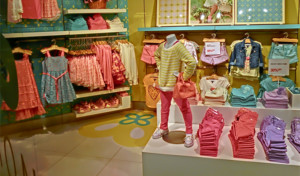
Indian consumers and their apparel preferences are gradually changing, which in turn is altering the shape and size of the apparel business. Indian apparel, which was all about showcasing the country’s rich cultural heritage, is slowly aligning itself to more refined and globally “on-trend” fashion.
The changing demographic and psychographic profile of the Indian consumers is today, supported by the apparel market which is increasingly moving away from tailor-made to readymade clothing.
The Indian consumer – who comprises the largest Gen Y population of the world with a median age of 27 years is also evolving in its shopping habits and buying behaviour.
The changes in the Indian economy are explicit and so is the impact of these changes on the apparel industry. Here’s a look at the five key consumption trends in India that will shape the future of the apparel industry and present significant opportunities for new as well as existing businesses.
New Middle Class & Its Soaring Aspirations

In India, people are shifting from rural to urban areas in search of jobs and better education at a continually increasing rate. By 2025, 37.5 per cent of India’s population is expected to be living in urban areas.
Furthermore, urban lifestyles and services are also spilling over to rural areas.
Together urbanisation and rurbanisation are adding new consumers to the middle class whose soaring aspirations are changing the dynamics of the apparel market.
By 2025, the middle class consumers which will form 48.5 per cent of total targetable customer base will contribute about 55-60 per cent share of total apparel market size.
The top tier cities will continue to remain dominant locations in terms of apparel market because of the presence of both middle class and affluent consumers. However, two-third of this middle class will dwell in the middle tiers and smaller cities as well as large district towns which are and will continue emerging as increasingly attractive apparel markets.
Smart Women & Smart Kids

India is one of the few countries where men’s wear has traditionally been a bigger market than women’s wear, but this is going to change very soon. Women’s wear market in urban areas is in the throes of change.
The role of women in Indian families is changing and with women contributing more to household income, their influence in family decision making is also increasing. Even women who do not work are also stepping beyond their homes like working women and taking up male roles and responsibilities, as family work gets redefined, driven by pressures of urban living.
On the semi-urban and small town side, this means more spend on apparel, increasing adoption of ready-to-wear apparel and increasing acceptance of western casuals.
On the urban side, with the rapid expansion of professional sectors in India where working conditions are more women friendly and hiring policy is inclined towards greater gender diversity, the number of women entering in workforce is constantly increasing. Hence, the need of dressing smart and willingness to look better is driving urban women to increasingly accept western wear.
 Also, smarter mothers are grooming smarter kids who have a lot of say in the purchase decisions. Kids are more aware about brands as they are exposed to media and surroundings more than ever. As a result, though quality remains paramount and price sensitivity high, the acceptability of brands for kids wear is increasing among urban consumers.
Also, smarter mothers are grooming smarter kids who have a lot of say in the purchase decisions. Kids are more aware about brands as they are exposed to media and surroundings more than ever. As a result, though quality remains paramount and price sensitivity high, the acceptability of brands for kids wear is increasing among urban consumers.
The kids wear market in urban India is expected to reach Rs 1,57,000 crore by 2025.
Functionality & Fashion Expanding Wardrobes

Urban consumers today buy apparel which serves a specific occasion / purpose. There exist urban consumers who buy apparel because of functional/performance benefits and hence brands introduced clothing lines on the concept of shape retention, anti-stain, anti-odour, anti-perspiration, quick dry, etc.
Another set of consumers has moved beyond functional to higher needs and prefers sustainable clothing that is good for the skin, clothing made under fair trade certifications, etc. This prompted many apparel retailers and brands to launch the organic clothing line made of organic cotton, bamboo fabrics and natural dyes, etc.
All the aforementioned developments are driving apparel retailers and brands to look beyond the predictable functional needs of urban consumers.
For driving the sales growth, brands and retailers are on one side, creating and serving the new occasions in the lives of consumers and on the other are innovating performance features that will prompt apparel consumption.
Urban consumers see apparel as a form of self-expression. They consider it a reflection of their personality and status.
Return of Custom-Fit Clothing

The men’s wear market in India transitioned from tailor-made to ready-made clothing due to the popularity of ready-made clothing among young and working Indian men. But now, the trend of custom-fit clothing in India is reviving. Custom-fit clothing is of two types – made-to-measure and bespoke tailoring.
In India, premium brands like Raymond and Louis Philippe as well as luxury brands like Armani, Versace, Zegna, Cadini and Canali offer made-to measure services. Premium brands like Van Heusen’s My Fit and Creyate by Arvind Group have also introduced bespoke tailoring in an attempt to capture the growing trend of custom-fit clothing.
The menswear ready-to-stitch market in India is expected to grow to Rs 46,500 crores by 2020.
Integration of Fashion & Technology

The increasing access to digital devices and Internet is enabling masses to have online shopping experience irrespective of whether they are living in urban or rural areas. Online shopping gives access to wider range of brands, convenience of shopping in indoor comforts and options to compare prices, products and read reviews. Moreover, enhanced customer services, social media engagements and concepts such as sales on weekends, holidays and festivals are helping online retailers attract a lot of new customers and also build loyalty among existing customers.
Online shopping today gives rich, immersive and personalised shopping experience to a customer and this is a major reason driving growth. While online apparel sales are growing, the opportunity to build digitally driven fashion brands is also emerging.
The success of digitally driven fashion brands will be driven by vast young population with access to technology and desire to be fashionable.
Wazir Advisors believes that business entities looking at entry into the domestic apparel market, or growth, could leverage one or more of the above trends to start and scale up their business.
The market growth and continuous shift towards brands will support new ventures, given the strength of the product and a clear growth strategy based on real consumer insights.
(Text Sourced From: India Business of Fashion Report 2017)


